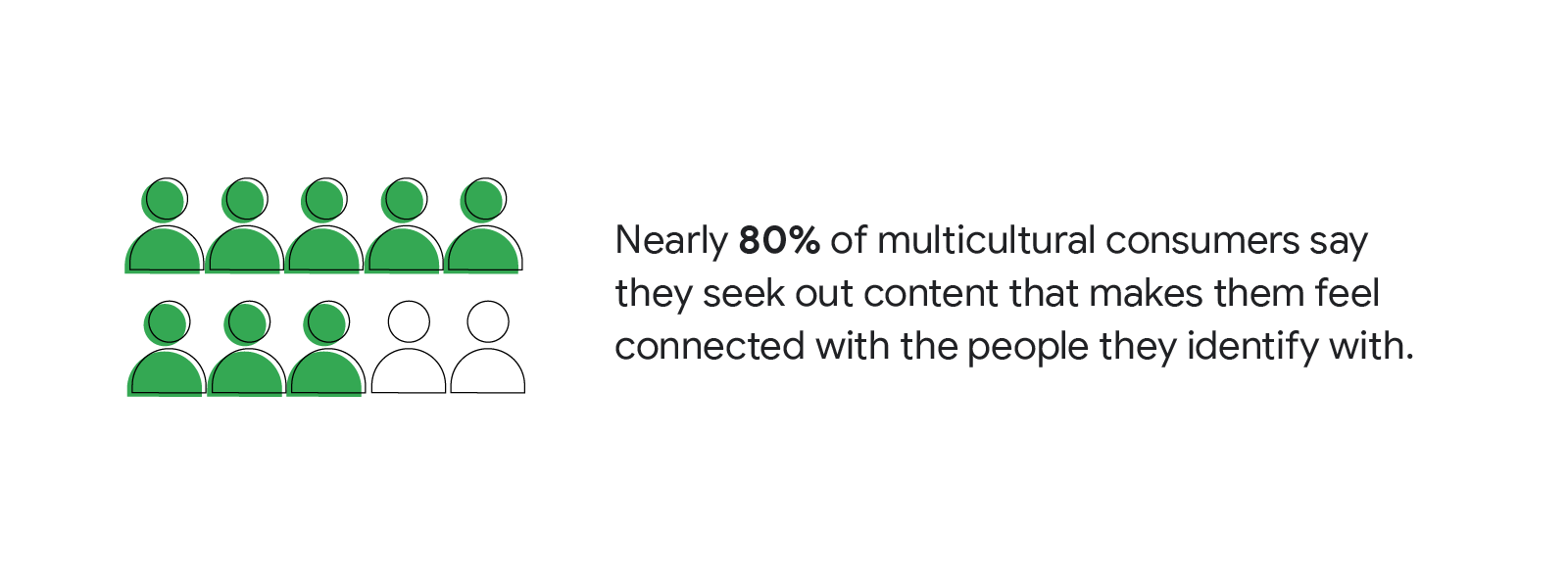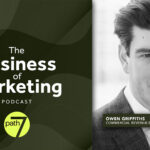By Chiquita Vaughn
Have you ever really wanted a brand of jeans, but no matter how many styles you tried on, they just didn’t fit? They were always too small at the hips or a little too short. After many try-ons, you accept that this brand is not for you. You never buy your first pair, let alone many pairs. And the brand lost a potential loyalist.
It’s not enough to show a Black or brown face in an ad and consider it ground breaking or progressive.
One way to achieve customer loyalty is to make sure people feel included in what your brand is doing or selling, and to signal clearly that your products are made for them. In a recent study, nearly 80% of multicultural consumers say they seek out content that makes them feel connected with the people they identify with.1
Two rows of five people icons, making 10 total. Eight of the people are shaded green, while two remain white. Nearly 80% of multicultural consumers say they seek out content that makes them feel connected with the people they identify with.

Think with Google
Google/Sparketing, U.S., YouTube Multicultural Marketing study, n=1,560 (n=500 gen. pop., n=306 Black, n=310 Latinx, n=301 Asian, n=318 LGBTQ+), U.S. people 18–54 who use YouTube a few times a month or more, Jan. 2021.
“It’s not enough to show a Black or brown face in an ad and consider it ground breaking or progressive. Customers want to see content that celebrates and normalizes positive portrayals of diversity,” says D.J. Vaughn, Walmart associate director of multicultural media and content.
In the U.S., where people from underrepresented communities make up 43% of the population, multiculturalism is obviously mainstream.2 Are you making sure that your jeans fit the diversity of experience represented in that category?
Walmart and McDonald’s are two brands that have led the way on inclusive messaging across cultural groups. Let’s examine their strategies.
Staying relevant during key cultural moments
Walmart has leaned into topics that were once ignored, because they matter to underrepresented communities.
A recent study found that 1 of 3 things multicultural consumers want to see is authentic representation.3 To that end, Walmart has used YouTube to break the mold by supporting content that Black audiences relate to.
You have to be intentional about your partnerships; it’s not just about who’s hot at the moment.
In 2019, it partnered with YouTube Black FanFest as presenting sponsor to build brand affinity with Black millennial consumers through a cultural moment: the homecoming festivities for Morehouse and Spelman, two prestigious historically Black colleges.
The brand was present throughout the experience with custom on-site activations, multiple digital integrations, and the first ever co-branded masthead on YouTube. The headlining show was live streamed with snackable clips that followed. To date, those clips have garnered over 150,000 views and the live stream resulted in 2.26 million views — a 3,275% increase from the year prior.
The momentum from that activation deepened through Walmart’s Storytime Series on YouTube. Created for adolescents, Walmart Storytime features books by Black authors and illustrators with narration from folks like LeBron James and Jimmie Allen, the first Black musician to be named the Academy of Country Music Awards’ New Male Artist of the Year.
Despite working with big names, Walmart is equally committed to elevating lesser-known but deserving talent. “You have to be intentional about your partnerships; it’s not just about who’s hot at the moment,” according to Vaughn. Brands have the power to create audiences for new voices, whether those voices are behind the scenes or in the limelight, a huge opportunity for culturally engaged marketers.
When asked what brands should consider when curating content on spaces like YouTube, Vaughn emphasizes that you can’t just show up based on the news cycle. Brands with a consistent presence convey authenticity. And, he says, every activation needn’t be a product push. It’s OK, even beneficial, to focus a campaign on the community without intention to sell.
Walmart will do just that through its next YouTube campaign, Black & Unlimited, which launched early March and saw phenomenal results in just two weeks. The series celebrates Black individuality by spotlighting Black creators who are blazing trails and defining what Black identity means to them. The first episode achieved audience reach over 1,341% above benchmarks, in addition to 4,000 likes and 457 overwhelmingly positive comments. With this work, Walmart aims to embrace the many intersections of Black identity.
Pivoting strategy to account for different audiences
McDonald’s has a long history of programs and initiatives geared toward customers from culturally diverse communities. But in recent years, the fast food giant has shifted its paid strategy to ensure its campaigns not only resonate with multicultural audiences, but also show up on the channels that are most relevant and authentic to them.
“If we want to engage our diverse fans in a meaningful and memorable way, we have to meet them where they are,” says Sheila Hamilton, McDonald’s director of media.
Historically, McDonald’s was highly sensitive to brand adjacency, implementing restrictive brand suitability settings across all YouTube campaigns. With a newfound focus on ensuring that its key messaging reflected the diversity of its consumer base, that had to change. In 2020, McDonald’s launched its “Famous Orders” campaign, partnering with artists like Travis Scott and Saweetie, to connect with consumers through hip-hop culture and music.
McDonald’s spotted a disconnect in reaching consumers from culturally diverse communities and refined its brand safety measures to be more inclusive.
The campaign was a hit, but despite hip-hop being the fastest growing of the top three music genres (including pop and rock) in the U.S., that success didn’t initially translate on YouTube.4 This was a puzzle. After all, the brand’s digital initiatives were all about reaching consumers where they spend most of their time, and McDonald’s research showed that YouTube captures a lot of that time on a significant scale.
“We looked at brand safety measures and recognized that certain [measures] meant we weren’t connecting with some of our audiences in places that were relevant and authentic for them,” according to Hamilton.
As it turned out, McDonald’s had previously excluded rap content from its targeting parameters due to language and thematic concerns, which meant “Famous Orders” advertisements had no presence on the channels of collaborating music artists. McDonald’s quickly spotted the disconnect in reaching multicultural consumers and refined its brand safety measures to be more inclusive.
“There are just certain things that are inherent to our brand. Music is a key component and has been for years,” says Hamilton. “We’re really trying to do it in an authentic way.”
To that end, McDonald’s collaborated with YouTube’s sales team to develop a new strategy for inclusive media buying practices. By moving from restrictive buying practices to limited mode, the brand was able to maintain brand suitability while also amplifying its hip-hop strategy across YouTube. As a result, hip-hop music exclusions were reduced by 32% in a six-month period.
As we can see with Walmart and McDonald’s, advertisers have many options to connect with multicultural audiences — staying relevant during key moments, leveraging tools to inform targeting decisions, and, most of all, keeping these audiences top of mind when creating video content. With multicultural viewers leading the streaming demographic shift, McDonald’s and Walmart have made YouTube the linchpin in their marketing plans and powerfully demonstrated how to engage beyond the norm.
This article first appeared on Think with Google.






